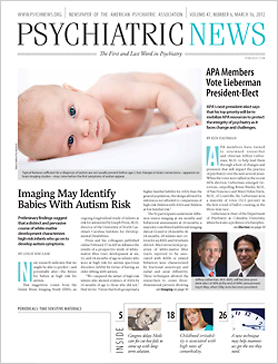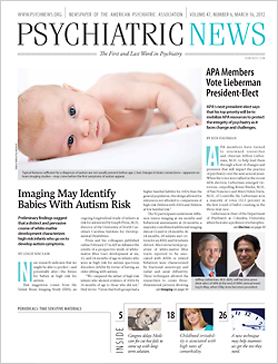Children whose mothers take the antiseizure medication valproate during pregnancy have a relatively higher risk of developing autism, although the absolute rate is still small, reported researchers at the American Epilepsy Society annual meeting in Baltimore last December.
The study adds to a growing body of knowledge indicating that valproate or related drugs can increase rates of behavioral teratogenic defects, now including neuropsychological effects, said Jakob Christensen, M.D., a consultant neurologist at Aarhus University Hospital in Denmark.
A separate study by American and British researchers of 311 children found “adverse cognitive effects” of fetal valproate exposure at age 6, reported Kimford Meador, M.D., a professor of neurology at Emory University. “That makes valproate a poor first-line choice for women who are or who might become pregnant,” he told Psychiatric News.
Although these studies were carried out in women with epilepsy, they may apply equally to women using the drug for other conditions, said Meador. Valproate is often prescribed for patients with bipolar disorder and resistant headache pain.
The Danish researchers, using national health registries, gathered data on 655,691 children born to 428,431 mothers between 1996 and 2006. They identified mothers who filled prescriptions for valproate at any time between an estimated 30 days prior to conception and the date of birth, and adjusted for parental psychiatric history, maternal age, and the child’s gender.
Results showed that 508 children were exposed to valproate in the womb, and 14 of them developed autism. The relative risk of autism spectrum disorder was 2.6 and for autism was 4.8, said Christensen. Among children not exposed to valproate, only 0.8 percent (or about 5 per 508) developed autism, he said.
“I think that the evidence linking valproate to autism is growing but not as strong as the evidence related to malformations or cognitive problems,” said Meador, who reported the latest results from a long-term study of prenatal exposure to valproate in which he is an investigator.
Outcomes at age 6 were similar to those observed at age 3 in the same cohort: an 8- to 10-point difference in IQ for those exposed to valproate. The higher the dose, the greater the difference in IQ scores.
Ordinarily, a mother’s IQ is a good predictor of the child’s, but valproate disrupts that usually strong association, he said.
These and other studies collectively indicate significant effects on behavior, cognition, and malformations, said Meador.
Valproate’s effects appear to be distributed throughout gestation, he said. Malformations (mainly cardiac and neural-tube defects, or hypospadias) seem to occur in the first trimester but timing of effects on cognition is not clear.
“There are some animal and alcohol data suggesting that those effects may happen in the third trimester,” he said. “So decisions about prescribing valproate should be made before pregnancy.”
In treating epilepsy, valproate is used only for cases of primary generalized epilepsy, and only a subset—about 15 percent—of women respond well to it, although that subset cannot be determined prior to treatment, he said. Other women could benefit from use of several other anti-seizure medications, like lamotrigine, levetiracetam, topiramate, or zonisamide.
Meador does not recommend switching from valproate during pregnancy because that exposes the fetus to polytherapy, which increased the risk of autism in the Danish study. However, pregnant women prescribed the drug for bipolar disorder could more safely stop taking valproate or switch to another medication because any onset of illness is slower than the much higher risk of convulsions in patients with epilepsy, he said.
“If a woman is already pregnant, I suggest using the lowest dose possible and spreading it throughout the day to reduce peak effects,” said Meador. “There are some data showing that peak effects are worse than total exposure.”


